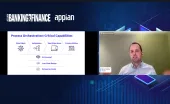
Data is the bane and boon of addressing sustainable investment gap
Wielding this tool the right way is key to pushing and meeting ESG goals, says Experian’s Sisca Margaretta.
Whilst data holds the power to make more informed ESG-related decisions, there is a gap between what companies need versus what data they currently have.
“A few years ago, we didn’t have enough data available to support ESG investing. Whilst there is much more data now, it’s fragmented across different sources, including company reports, news articles, data vendors, and rating agencies," Sisca Margaretta, chief marketing officer, EMEA & APAC at Experian, told Asian Banking & Finance in an interview.”
In a separate study, professional services firm EY also found that 46% of asset managers and 25% of banks find the lack of real-time ESG data to be limiting.
The lack of standardized, defined benchmarks means much of the ESG data companies are providing right now is not useful enough to support investment decisions, she added.
“Beyond problems like inadequate disclosure and data availability, a lot of companies today also adopt practices like ‘greenwashing’ – which refers to using marketing tactics to over-amplify their ESG efforts – to gain favor from stakeholders,” Margaretta warned.
In a survey of 6,000 bank customers globally, cloud platform provider Mambu found that over 67% of respondents believe that their banks are guilty of greenwashing: that is, they believe that their banks are overstating their sustainable-related efforts. In financial hub Singapore, that's 68% of respondents.
ALSO READ: Banks’ tech risks intensifies as digitization ramps up: Fitch
This is where a system of checks and balances becomes essential to make sure that any and all ESG data is honest and reliable, according to Margaretta.
Sharing the right information is also key to ensuring that consumers are aware of banks’ ESG.
Raising investments
Beyond beating away reputational risks and meeting the increasing sustainability mandates of both regulatory bodies and the public, the right use of data can also push up investment activities in the ESG space.
“When reliable and adequate data is made available, investments tend to rise. Given that over 90% of the world’s data has been created in the last five years, we have ample information to drive fund allocation towards sustainable causes – provided we choose and interpret it efficiently,” Margaretta said.
Margaretta noted the growing awareness around ESG investing over the last few years, which in turn made it a central concern for the financial sector. A chief player to this push are the younger generation of investors, who were noted to be “passionate about addressing systemic concerns like climate change and social inequalities.”
“As this cohort moves up the corporate ladder, they have more assets at their disposal to address these issues through responsible investment,” she added.
ALSO READ: ASEAN regulators ramp up blockchain adoption as tech expands beyond crypto: analysts
Another factor is increased global awareness for action towards environmental preservation, culminating with the UN Climate Change Conference (COP26) held late 2021, which further brought this issue to the forefront for both governments and private players.
These factors are collectively enabling massive growth in both the volume and diversity of ESG investing, and it is now estimated that ESG assets will account for a third of the projected total assets under management globally, surpassing $41t by the end of 2022 and $50t by 2025, according to Margaretta.
All these makes data all the more a necessary feature of winning in, and thriving, at the sustainable finance space.
“Technology will play a key role in shaping the future of sustainable finance,” Margaretta said, adding that tools like artificial intelligence (AI) and machine learning can address challenges, “by developing models to make sense of varied data sources.”
ALSO READ: Digitalisation vs digitisation: How they differ in transforming the banking industry
“They can also go a step further by integrating different datasets into a comprehensive view – eliminating the bulk of noise, whilst retaining the information that truly matters,” she added.
“Analysing and processing ESG data is a relatively new and evolving concept. The industry needs to remain agile in order to continue adapting to developments in the landscape,” Margaretta concluded.
















 Advertise
Advertise






